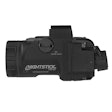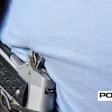We go into the field every work day with myriad tools. Straight sticks, ASPs, PR-24s, pepper spray, handcuffs, gun belts, holsters, body armor, firearms, and backup firearms are all essential tools for the modern day law enforcement officer.
But one thing I, for one, never gave much thought to is the ammunition we are most likely issued by our respective departments. There are so many different brands, calibers, and performance characteristics to consider that it's mind boggling.
Ammo Considerations
I started thinking about ammo a whole lot back in December when I became the rangemaster for the San Diego Police Department. Before that I just went to the range, practiced a good amount, and qualified when required just like the rest of the cops on the department. Back then the only time I ever really thought about differences in ammo performance was when each year, during one of the qualifications, I was directed to shoot my duty loads. This was done to make sure that we were all familiar with the point of impact of duty ammo Vs. the less expensive practice ammo we shot at other times. It also kept fairly fresh ammo in our guns for when it was really needed.
Now, as part of my duties as rangemaster, I think about ammunition all the time. My new considerations for ammunition are things like velocity, bullet type, penetration, and, most of all, consistency of "downrange performance." That's a nice way of saying the bullet enters a suspect's body and does as much damage as possible so as to end the fight quickly and efficiently.
I also spend a lot of time talking to the reps of ammunition companies. You see, larger agencies like mine are often courted by the big ammunition manufacturers because if a large agency adopts a specific ammunition type, it acts as a sales multiplier for the manufacturer. When selecting their duty loads, smaller agencies surrounding major metropolitan centers piggyback on research and testing performed by the large agency. It's not secret stuff. Agencies big and small need to share information when it comes to selecting ammunition.
But what's good for one agency may not be the best choice for another. Ammunition performance requirements for an agency in Southern California, Puerto Rico, or Florida may not be the same as those for a department in Montana, Minnesota, or northern Michigan. A different bullet configuration is needed when penetrating a parka, wool sweater, flannel shirt, and thermal underwear Vs. a Hawaiian shirt or that "I hear dumb people" T-shirt.
Testing Ammo
Agencies need to test ammunition performance for their particular needs and applications. For example, if the climate is very cold, it can affect powder and even primer performance. Barrier penetration can also be a real consideration in rural environments.
This is why the FBI developed a comprehensive testing procedure for ammunition performance. The FBI Penetration Test is designed to determine information regarding a particular cartridge, including penetration performance, expansion of the projectile, retained weight of the projectile, and average velocity from a test barrel and a service weapon.
The test medium is 10-percent ballistic gelatin, by weight. Tests one through six are shot at a distance of 10 feet from the muzzle to the first barrier. Tests seven and eight are shot at a distance of 20 yards from the muzzle.
Test One: Bare Gelatin
Test Two: Heavy Clothing-The gelatin block is covered with four layers of clothing. One each of the following: cotton T-shirt material (approximately 48 threads per inch and 5.25 ounces per square yard), cotton dress shirt material (approximately 85 threads per inch and 3.5 ounces per square yard), a down comforter (500 to 550 fill power) in a cambric shell (approximately 232 threads per inch), and denim (approximately 50 threads per inch and 14.4 ounces per square yard). The shots are fired so as to not impact on a stitch line of the comforter.
Test Three: Steel-Two pieces of 20-gauge, hot-rolled steel with a galvanized finish are set three inches apart to simulate a car door. A gelatin block covered with a T-shirt and a dress shirt is placed 18 inches behind the rear-most piece of steel.
Test Four: Wallboard-Two pieces of half-inch standard gypsum board are set 3.5 inches apart to simulate an interior building wall. The gelatin block is placed 18 inches behind the rear piece of gypsum.
Test Five: Plywood-One piece of three-quarter-inch "AA" fir plywood is used to simulate a typical wooden door. The wood is set up 18 inches in front of the gelatin block.
Test Six: Automobile Glass-One piece (15x18 inches) of A.S.I. quarter-inch laminated automobile safety glass is set at an angle of 45 degrees to the horizontal and 15 degrees to the side, resulting in a compound angle. The gelatin block is placed 18 inches behind the glass. This test event simulates a shot taken at the driver of a car from the left front quarter of the vehicle.
Test Seven: Heavy Clothing at 20 yards-This test event repeats test two, but at 20 yards. Test Eight: Automobile Glass at 20 yards-This test repeats test event six, but at 20 yards and without the 15-degree horizontal offset. This simulates a shot at the driver of a car bearing down on the shooter.
That's how police ammo is graded by the FBI. The following is a quick look at some likely candidates for your own testing.
ATK Alliant Techsystems
ATK is a giant in the ammunition business. Federal Cartridge and Gold Dot/Speer are two of the companies operated by this large conglomerate, which makes everything from rocket motors to .22 caliber shells, and that includes literally billions of rounds of ammunition for the military.
ATK's Federal Premium Ammunition comes in all of the calibers used by law enforcement in the United States. Its new HST, in 9mm, .40 caliber, and .45 caliber ACP, is a "law enforcement only" ammunition that offers outstanding penetration and expansion characteristics. The expansion is consistent in practically any medium. The 230-grain .45 ACP round provides 11.5 inches of penetration and expands to .74 inches. Now that will leave a mark.
Federal Classic Ammunition is also used by hundreds of law enforcement agencies across the nation and abroad. And its Hydra-Shok rounds have shown consistent performance for years. Hydra-Shok is produced for .380, .38 Special, 9mm, 357 SIG, .357 Magnum, .40 S&W, 10mm, and .45 ACP. The defining characteristic of Hydra-Shok bullets is a center post in the hollow point that improves performance when penetrating many layers of clothing and provides controlled expansion.
Speer is another ATK company that offers a full line of law enforcement ammunition. Speer's Gold Dot is high-quality ammunition that offers outstanding performance, and it is very popular with police agencies.
And with good reason. Jacket/core separations are one of the primary causes of bullet failure. Most bullets perform adequately in soft tissue, but fragment or expand prematurely when obstructed by bone, heavy clothing, or any number of other potential real-life shooting barriers. Conventional bullets are made by forcing a lead core into a jacket, creating a two-piece bullet design. Gold Dot was the first handgun ammunition to be loaded with high-performance bonded core bullets. Speer's Uni-Cor process bonds the jacket to the core one molecule at a time, virtually eliminating core jacket separations.
Black Hills Ammunition
Started by a cop named Jeff Hoffman about 20 years ago, Rapid City, S.D.-based Black Hills Ammunition produces new ammunition for all four branches of the U.S. Military, including all current contracts for 5.56 match ammunition. It also supplies duty and training ammunition to many law enforcement agencies nationwide. Black Hills makes a variety of high-quality police ammo, ranging in size from .380 pistol to .338 Lapua rifle cartridges.
Hornady Manufacturing
In 1949 Joyce Hornady and his original partner Vernon Speer built a machine that converted spent .22 rimfire cases into bullet jackets, and then into bullets. These bullets sold well all over the country. Using a surplus bullet assembly press, he also began to produce .30 caliber bullets.
Today Hornady produces a line of high-quality ammo, including its well known TAP (Tactical Application Police) rounds for law enforcement distribution. TAP is specifically designed for law enforcement applications and is produced in all the common police calibers for pistols and rifles.
PMC Ammunition
Since the 1980s, law enforcement agencies and private citizens have put their trust in the superior performance of premium-grade PMC (Pan Metal Corp.) Starfire cartridges imported from South Korea. In 1988, the company purchased factory facilities near Boulder City, Nev., for the production of ammunition to supplement the Korean imports and for the purpose of producing two new lines of high performance cartridges: the Starfire handgun ammunition for law enforcement and X-Bullet rifle ammunition for big game hunting.
Starfire not only features broad expansion to ensure that more stopping power is delivered on target. It also offers an optimal average penetration of 10 to 14 inches. The key to Starfire's broad, extremely reliable expansion over a full range of calibers is its high-tech, patented rib and flute design. Five sharp-edged ribs in its deep hollow- point cavity stretch apart on impact, hyper-expanding the bullet to nearly twice its original diameter, with virtually no fragmentation or weight loss.
Remington Ammunition
Remington is one of those names that is synonymous with firearms. It's steeped in well over a hundred years of American firearms history. But Remington is also a forward-thinking company that's known for its innovation and technology.
Consider, for example, Remington's Golden Saber bullets. Through an exclusive process, the Golden Saber's lead core is hot-bonded to the brass jacket. The result is exceptional weight retention, up to 97 percent when fired through automobile glass. In addition, expansion, penetration, and weight retention performance when fired through barriers such as wallboard and plywood has also been improved. The unique design and bonding process also produces a bullet that requires less energy to initiate expansion. At the same time, the jacket stiffness and wall thickness is designed to eliminate overexpansion, thus maximizing penetration. These characteristics make Golden Saber and Golden Saber Bonded very good choices for law enforcement applications.
TTI Armory Ammunition
TTI Armory is relatively new to the small-caliber ammunition market. TTI specializes in match grade, subsonic, frangible, and lead-free ammunition, and the company supplies domestic and foreign military units, federal and state law enforcement agencies, and recreational competitive enthusiasts.
TTI is an up and comer in the market, and with good reason. The company's manufacturing processes are strictly 21st-century, employing state-of-the-art automated loading machinery along with patent-pending technology that measures the cartridge components down to one-tenth of a grain. Its focus is to make consistent, accurate, and reliable ammunition. And judging from the list of some of its buyers, including various big police department SWAT teams, federal alphabet agencies, and high-speed, low-drag military outfits, TTI is pleasing some very tough customers.
TTI's specialty is ammo for tactical applications. For example, the company has developed a new line of subsonic ammunition engineered specifically to be fired through a suppressor. This ammunition is capable of MOA (approximately a one-inch group at 100 yards) accuracy when fired through any common barrel twist rate and any premium commercial suppressor. It achieves such accuracy because it is engineered to deliver a high-quality stabilized bullet with high impact at a reduced velocity. The new round will not interfere with suppressor baffles and has no harmful fillers. It even looks cool, with its patent-pending black brass case. Actually, the black case was really designed for easy identification and low observability.
Winchester Ammunition
For more than 125 years, Winchester has taken great pride in working closely with law enforcement organizations and agencies to meet our changing needs. Winchester developed the .38 Special, 110-grain +P+ jacketed hollow-point cartridge for the U.S. Secret Service in the 1960s. Then in the 1970s, Winchester responded to new FBI requirements for a .38 Special 158-grain hollow point. In the 1980s, the company was asked to develop solutions for the military and law enforcement for high-performance 9mm ammo. Winchester's response was the 9mm Super-X subsonic round for the Navy SEALS and a complete line of Super-X Silvertip hollow-point cartridges for law enforcement.
Today, Winchester continues its innovation with new products that meet and, in most cases, exceed our toughest requirements. The new Ranger "T" Series Handgun Ammunition and the new Ranger Partition Gold Handgun Ammunition are outstanding performers used by hundreds of law enforcement agencies across the country and abroad. Additionally, the company has developed reduced hazard and non-toxic training ammunition. Its WinClean, Super Clean NT, and Ranger Frangible ammunition lines are widely used on police ranges.















